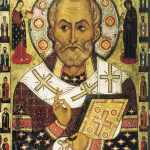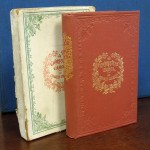The Beginnings of the Christmas Spirit

St. Nicholas “Lipensky” later in life, from a Russian icon in the Lipnya Church of St. Nicholas in Novgorod, circa 1294.
Though the Christmas celebration of gift-giving and caroling falls on the same evening as the Western Church celebrations of the birth of Jesus Christ, the two are not inherently related. At first, the celebration of gift-giving as a treat for the children was celebrated on December 6th, when Saint Nicholas of the Catholic church had his feast day. Legend states that as a young man entering the monastery in the 4th century AD in present-day Turkey, St. Nicholas was required to give up all of his worldly possessions. According to the story, Nicholas did so – and chose a poor family to bestow his “gifts” to in the night – placing gold coins in the shoes of the daughters, as well as leaving items in stockings hung over the bed posts. Saint Nicholas became known for his love of children and as a giver – and thus the traditions of the holiday began.
Many countries have adapted the story of this famous “gift-giver” for their own purposes – and the man so claimed can be identified under many names, including: Sinterklaas (the Netherlands), Father Christmas (United Kingdom), Pelze-Nichol (Germany), San Nikola (Italy), Pere Noel (France), Grandfather Frost (Russia), Niklaus (Austria), Joulupukki (Finland) and even Lan Khoong (China). Some countries have adapted the birth of Jesus Christ to the holiday, transforming the Christ child into the gift-giver. In any case, the holiday celebration has long included the tradition of gift-giving, especially for children.

The Look of Santas around the World! If you ask me (which you didn’t, but I will tell you my opinion anyway), the US Santa could stand for going on a juice cleanse.
The History of Christmas Celebrations in America
Christmas had tenuous beginnings in the new lands settled by the pilgrims. These English separatists, who in 1620 journeyed to what was eventually to become the United States, were conservative in their religious beliefs and frowned upon all mention of the holiday. In fact, from 1659 to 1681, the celebration of Christmas was against the law in Boston.
The Christmas Spirit truly began to be recognized in early America (finally!) in the later part of the 1800s. Christmas was recognized as a federal holiday in 1870 (though states began to recognize it as a legal holiday as early as 1836 with Alabama leading the continent in appreciating the Christmas spirit). In the years following the Civil war, Christmas traditions spread like wildfire across the country – in large part due to the further propagation of children’s literature across the states.
Significant Pieces of Christmas Literature in English
North America had, quite obviously, a bit of a later start with the formation of our idea of Saint Nicholas than European countries did. But with the help of our English-speaking counterparts in the United Kingdom, there are quite a few important English works on the subject of Christmas, Yuletide, and the holiday collectively. Of course, one of the most famous pieces of writing done on the subject of Christmas was the 1822 poem “A Visit from St. Nicholas” or what you might know as “’Twas the Night Before Christmas”, written in New York by Clement Clarke Moore as a bedtime story for his young children. After the (anonymous) publication of this poem in 1823, Christmas stories for children became an even more established writing subject.

Why yes, as a matter of fact this facsimilie of the 1st edition of “A Christmas Carol” is available for purchase through our website! Click here>
We would not be Tavistock Books if we didn’t, in some way, tie many of our blogs to our main man – Charles Dickens. In Victorian England Christmas reigned supreme, due largely to Queen Victoria and Dickens himself. Queen Victoria reputedly once remarked on her fondness for Christmas Trees covered in candles and presents, which immediately sparked the popularity for such in households around the country. Charles Dickens, penning such Christmas titles as: A Christmas Carol, A Christmas Tree, The Cricket on the Hearth, The Chimes, The Battle of Life & The Haunted Man, largely helped shape the image of Christmas that was taking root across the country in the Victorian period. In fact, Dickens helped fashion a good number of Christmas phrases, including the obvious “Bah! Humbug!” as well as increase the popularity of the expression “Merry Christmas!” through his works.
Popular Christmas titles have been written in almost all languages. In the English-speaking world, holiday literature (mainly for children) has remained a popular genre since the publication of A Visit from St. Nicholas. Some of the non-Dickens popular titles you may recognize are Old Christmas (Washington Irving, 1875), A Kidnapped Santa Claus (Frank L. Baum, 1904), How the Grinch Stole Christmas (Dr. Seuss, 1957), and The Polar Express (1985). While these are just a handful of the more popular titles to emerge in almost the last two centuries, Christmas literature does seem to have skyrocketed in quantity with the popularity of Christmas that has been spreading since the beginning of the 19th century.
And in keeping with the joyous Christmas spirit now permeating the land, we here at Tavistock Books want to wish all our friends, colleagues & customers the very best of holidays, and will close this piece by offering a quote of Tiny Tim’s, “God bless us, every one!”


